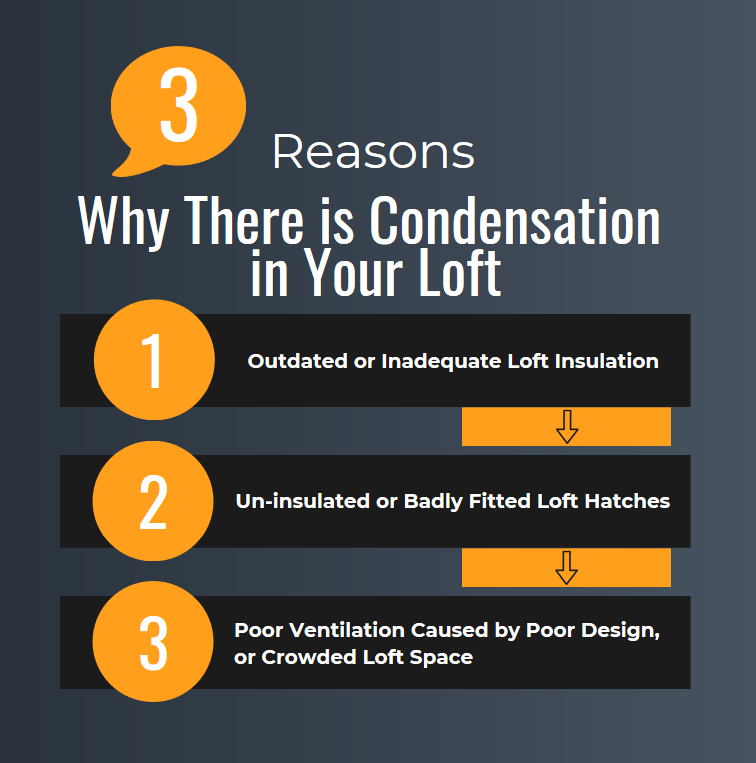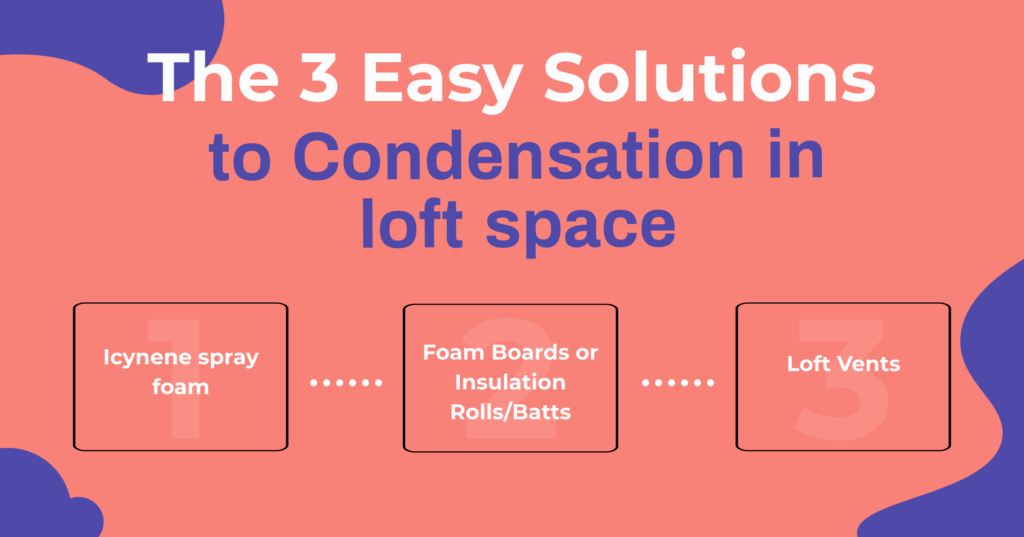Table of Contents
FAQ: Why is there condensation in my loft?

- Outdated or Inadequate Loft Insulation:
Condensation in loft space is especially common in homes that have inadequate insulation or traditional insulation such as fiberglass has not been fitted correctly. This can restrict your properties ability to “breathe” and condensation in lofts generally occurs when humid air makes its way through insulation or other gaps into the loft space and comes into contact with your cold roof tiles, it will condense into water and cause condensation. Get a free survey by clicking here to ensure that your loft insulation is installed correctly.
- Un-insulated / Badly Fitted Loft Hatches:
Another cause of condensation in loft space is poorly insulated or badly fitted cheap loft hatches. This is because they allow moisture laden air to enter the loft space and If the loft space is unable to breathe, this moisture laden air will build up. As it rises, on contact with the cold roof slates or membrane, this warm air will condensate and turn into water; which essentially will then flow down the inside of the roof, and form pools of damp in loft space.
- Poor Ventilation Caused by Poor Design, or Crowded Loft Space:
According to the roofing specialists, modern roof designs now incorporate ventilation along both eaves and ridge which encourages the free circulation of air to prevent problems such as condensation. Water laden hot air (the primary cause of condensation) rises and is allowed to escape through ridge vents, whilst colder air (the same temperature as the roof, replaces it through the eaves.)
Many older buildings may only use the odd tile vent to ventilate the roof space and some roofs may not have any ventilation system at all.
However, after carrying out many free loft surveys we have discovered that sometimes it may be the homeowner’s fault. It is all too easy to fill the loft with so many boxes, that air is unable to circulate.
Homeowner Tip: It could be that one or two boxes are obstructing vents, effectively rendering them useless, so the next time you go up in your loft, make sure you check as this simple trick can help prevent condensation in loft.
How to Stop Condensation in Your Loft

Condensation in loft space solution #1: Icynene spray foam
By far and away the easiest way to prevent condensation in your loft space is to install Icynene spray foam insulation. This is because Icynene battles both interstitial condensation and condensation. Unfamiliar with the difference between these two types of condensation? Allow us to explain:
Interstitial condensation happens on the inside of a structural material, whereas condensation happens on the outside. Let us use roof timbers as an example. Condensation happens when warm air comes into contact with your cold timbers. Upon contact, the warm air cools, reaches its “dew point” and forms water droplets on the outside of the timbers.
Interstitial condensation, on the other hand, occurs within the structural elements in your home. Interstitial condensation happens when warm, moist air penetrates inside a structure – such as your roof timbers – cools, and then condenses into liquid water.
Icynene effectively combats both of these types of condensation because its open cell structure allows your timbers to breathe and is the No.1 solution
Firstly, its “bi-directional” drying quality ensures moisture in your roof’s timbers “can escape through the insulation as the building dries out…eliminating moisture that could cause rot or mould”. Therefore, Icynene’ s breathability greatly reduces the risk of interstitial condensation.
Secondly, it prevents condensation in your loft space by warming up your loft.
As your roof is significantly colder than the rest of your house, heat rises up and out of your roof via convection. In roofs that have little or no insulation, condensation and interstitial condensation can form when the rising warm air connects with the cold surfaces in your roof – like your timbers. Icynene minimises the development of condensation in your loft space by creating a warmer environment.
With Icynene installed, rising warm air is less likely to form condensation when it connects with your timbers. This is because the timbers will not be as cold as they would be if there was no insulation installed in your roof. A warmer, well-insulated roof will also result in a cosier home, as less warm air will leak out of your roof via convection. And who doesn’t want a cosier home?
But there is another reason why we champion Icynene as the easiest method of preventing condensation build-up in your roof space.
The reason is this: you do not need to install additional air vents to experience a massive reduction in condensation.
Icynene is BBA approved for its “low water absorption, certified breathability, vapour diffusion and bi-directional drying qualities”.
This means that if you install Icynene spray foam insulation, it is highly unlikely that you will need to spend extra money on additional air vents (and someone to professionally install them).
Icynene’ s certified breathability allows all materials in contact with it to breathe naturally – greatly reducing the chance of dangerous levels of condensation forming in your roof space.
Conquer the condensation problem in your loft space. To have an expert member of our teamgive you a FREE quote for Icynene that is valid for 12 months, contact us here or call us on 0800 689 1894.
Condensation in loft space solution #2: Foam Boards or Insulation Rolls/Batts
Foam boards are rigid panels of insulation usually made of either polystyrene, polyisocyanurate, or polyurethane. Rolls/batts of insulation are typically made of fibreglass, but they also come in the form of other materials such as mineral (rock and slag) wool, plastic fibres, and natural fibres, such as cotton and sheep’s wool.
Foam insulation boards and insulation rolls/batts are an adequate, relatively low-cost option for reducing condensation in your loft.
They are installed by cutting the board – or roll/batts – into the desired dimensions and placing them in between your roof rafters. But be aware: cutting the boards, rolls or batts to the right size may be tricky. If you are cutting fibreglass, you will also need to wear protective gloves, glasses and a mask.
This is because direct contact with fibreglass materials or exposure to dust may irritate the skin, eyes and airways, causing a scratchy throat and coughing, and may worsen existing respiratory problems like asthma or bronchitis.
However, foam boards and insulation rolls/batts are effective at decreasing the amount of condensation in your loft space. This is due to the fact that they reduce conductive heat loss through the structural elements of your roof.
Reducing conductive heat loss makes your loft warmer, and this helps to decrease the condensation in your loft space – because the number of cold surfaces available for warm air (rising from the lower portions of your house) to form condensation against will be reduced.
If you install foam boards or insulation rolls/batts, it is likely you will also have to purchase and install a Vapour Control Layer (VCL) – or extra ventilation – to properly prevent condensation in your loft space.
Many foam boards and insulation rolls/batts are not breathable in the same way Icynene spray foam insulation is.
Therefore, it is recommended that you install a VCL to minimise the development of interstitial condensation.
Condensation in loft space solution #3: Loft Vents
The last way to solve condensation in your loft space is by installing loft vents. A common roof ventilation method is to install soffit vents in conjunction with additional loft vents like ridge or gable vents.
Soffit vents encourage the gentle movement of air in your loft space by drawing cool air from into the loft from the outside. The loft vents higher up in your roof – like ridge and gable vents – then take this air and pull it up and out of your loft, maintaining the flow of air throughout the loft space.
Loft vents help to move moisture-laden air (which may condense and cause mould) up out of your roof space – ultimately reducing condensation.
Although loft vents are a good way of limiting condensation build-up in your loft space, they do have some disadvantages.
For example, felt lap vents – which are installed in between the laps of a roof’s underlay – can adversely affect the driving rain resistance of slates, tiles or shingles, as well as increase the wind uplift forces acting on them.
Installing soffit vents alone may leave air trapped at the top of your attic, so it is recommended that you use a combination of soffit vents and ridge insulation for optimal roof space ventilation.
Lastly, having too many roof vents will create more points of entry for water to potentially leak through your roof. Don’t go overboard with the vents – or you might be doing some venting yourself!





